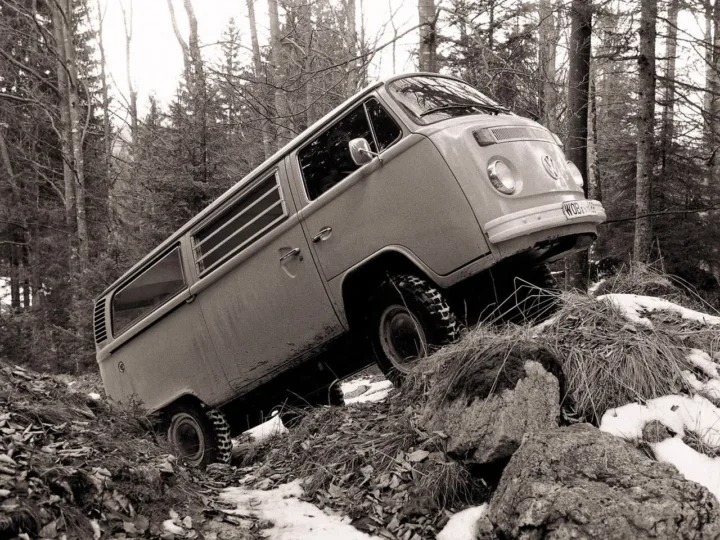Volkswagen's first all-terrain van was created half a century ago
Volkswagen has been producing off-road vehicles since the very beginning of its activities. After the end of World War II, however, this type of vehicle, associated with the motorized parts of the Wehrmacht, was completely excluded from the company's range, at the expense of popular passenger models. This idea was revived only in the late 60s by Gustav Meyer, who was at the same time the chief engineer in the Volkswagen light commercial vehicle department. In addition to being an engineer, he was also an avid road traveler, who made a total of nine crossings through the Sahara Desert, the first of which was made back in 1968. Meyer had the opportunity to travel to many other places in the world, and often came across difficult roads where the presence of a 4x4 and additional ground clearance would be of great benefit. He shared his idea with his colleague engineer Henning Dueckstein and in January 1975 they began development of the first factory-produced four-wheel drive minibus. At that time, the project was not yet known to Volkswagen's top management, which meant that the two engineers were practically working on it only in their free time, using whatever parts they could get their hands on at the factory garnitura chiuloasa corteco pret.

The SUV prototype is based on the Volkswagen T2 and is powered by a 2.0-liter, air-cooled four-cylinder engine that produces 70 horsepower at 4,200 rpm. It uses a semi-automatic transmission, similar in design to the Stickshift automatic module that is installed in some of Volkswagen's production models. This means that gears are shifted manually, but the torque converter eliminates the need for a clutch pedal.
Under normal driving conditions, power is sent only to the rear wheels, but a special lever mounted inside the cab allows the driver to engage the front differential even while driving. Installing a drive axle under the front floor panels requires several modifications, as well as repositioning the entire heating system. The suspension has been adapted for operation on rough terrain, and the van's vital mechanical components are protected by thick front and rear plates. The exhaust pipe is integrated into the side of the rear bumper, and the front bumper is raised by about 8 cm, which gives the van an attack angle of 30.5 degrees and a departure angle of 22.5 degrees. Ground clearance has been increased by installing 16-inch steel wheels and high-profile tires. To ensure trouble-free overcoming of water obstacles up to 50 cm, the outer and inner parts of the fenders have been increased. The maximum speed of the SUV reaches 120 km/h on flat terrain.
Although most T2s began to be equipped with disc brakes on the front wheels as early as 1971, the four-wheel drive model was equipped with drum brakes. Interestingly, the handbrake could be applied independently to each of the rear wheels. In December 1975, the first all-terrain prototype, painted in red and white, was sent for testing in Algeria, where Meyer was able to test it in the Sahara Desert while on holiday with his family. The drivetrain was far from perfect, but the van's off-road capabilities were impressive.
However, in early 1976, Volkswagen CEO Tony Schmücker ended the project, but Mayer and Dueckstein decided to continue, resulting in several more prototypes. According to Volkswagen's company archives, a total of five four-wheel drive examples were built by 1978, including a Westfalia camper van.
It is interesting to note that in 1978, when Volkswagen presented its military model Iltis to an engineering commission of the German army, one of the five T2 off-road prototypes was also on display. Both vehicles participated in the demonstration, with the van proving to be more capable off-road than its intended front-engine counterpart, but nevertheless, it once again did not receive the green light for series production. If a similar project had been presented to Volkswagen’s CEO a decade earlier, it probably could have become part of the production range, but in the 1970s the company’s priorities were different.
Ultimately, the idea of Meyer and Duxstein was able to reach practical realization in 1984 with the debut of the production Volkswagen Vanagon Syncro. It was developed with the help of the Austrian company Magna Steyr and technically differed greatly from the experimental T2, but the general idea of a van with four-wheel drive remained the same.
- 2025-02-13 - 40 years since the premiere of that Renault that was a threat to Ferrari and Porsche
- 2025-02-11 - Is 89 kilometers of mileage enough?
- 2025-02-10 - Renault ushers in a new era with electric light commercial vehicles
- 2025-02-08 - De Tomaso Pantera L: the forgotten Italian-American V8 legend
- 2025-02-07 - 1.8 percent of cars in Europe are electric
- 2025-02-06 - Renault 21: a strong echo of 1980s fashion
- 2025-02-05 - The 5-door Jimny attacks another market
- 2025-02-04 - The new BMW M3 CS Touring: with the family and 550 hp on the track
- 2025-02-03 - European car industry against CO2 fines
- 2025-02-02 - Business in 2024: Market slows down Bosch growth












